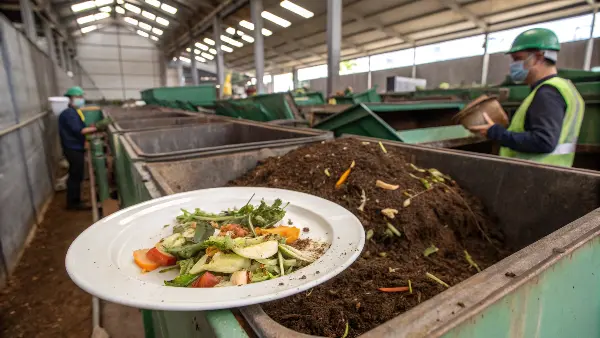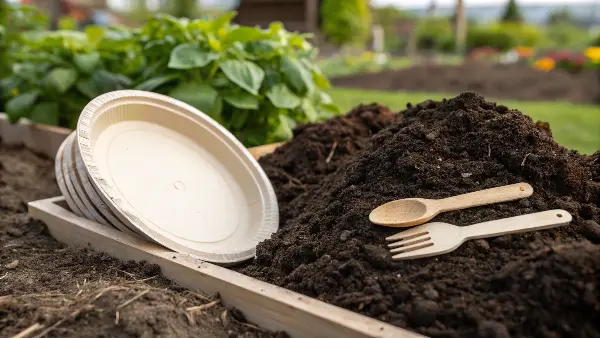Choosing eco-friendly options feels right, but do you worry if compostable tableware is truly sustainable? It’s easy to feel uncertain about the real impact. Let’s trace the journey to see if it lives up to the promise.
Ideally, compostable tableware follows a circular path: made from renewable plant resources, used briefly, then broken down in an industrial composting facility to enrich the soil, reducing landfill waste and reliance on fossil fuels.
Understanding this journey is key. When buyers like Jacky look for sustainable packaging solutions for their Canadian brand, they need confidence that the products we supply at Ecosourcecn offer genuine environmental benefits. It’s not just about the material; it’s about the entire system, from how it’s made to how it’s disposed of. Let’s dive into each stage of this lifecycle.
How Are Sustainable Materials Sourced and Made into Tableware?
| You want sustainable tableware, but are the raw materials themselves sourced responsibly? Choosing products made from poorly managed resources can undermine your green goals. It’s vital to know the origin story. Sustainable tableware starts with renewable resources like corn (for PLA), sugarcane residue (bagasse), or responsibly farmed trees (paper). These are processed using methods designed to minimize environmental impact before being manufactured into final products. ! The journey begins long before the plate or fork takes shape. It starts with the plants. For Polylactic Acid (PLA), often used in clear cups and cutlery, the process usually begins with corn starch. This starch is fermented to produce lactic acid, which is then polymerized to create PLA pellets. For bagasse products, like plates and containers, the raw material is the fibrous residue left after sugarcane stalks are crushed to extract their juice – essentially, it’s an agricultural waste product given a second life. Paper products rely on wood pulp, and here, responsible sourcing is key – look for certifications like FSC (Forest Stewardship Council) which ensure the wood comes from sustainably managed forests. The manufacturing process then transforms these raw materials. PLA pellets are melted and injection molded or extruded; bagasse pulp is mixed with water and molded into shape under heat and pressure; paper pulp is formed into cups or plates. Energy and water efficiency during manufacturing are important factors in the overall footprint. At Ecosourcecn, we prioritize suppliers who demonstrate responsible sourcing and efficient production, often verified by certifications. |
Material | Primary Source | Key Processing Step | Sourcing Consideration |
|---|---|---|---|---|
| PLA | Corn Starch | Fermentation & Polymerization | Non-GMO, agricultural inputs | |
| Bagasse | Sugarcane Fiber | Pulping & Molding | Utilizes agricultural waste | |
| Paper/Wood | Trees (Wood Pulp) | Pulping & Forming | FSC Certification |
What Happens After Use: The Crucial Composting Stage?
You’ve used a compostable plate, now what? Tossing it in the regular trash means it likely ends up in a landfill, completely wasting its potential benefits. Proper disposal is everything for these products.
After use, compostable tableware must go to an industrial composting facility. These sites provide the specific high heat, moisture, and microbial conditions needed for items like PLA and bagasse to fully break down within a set timeframe (usually 90-180 days).
 This is often the most misunderstood part of the lifecycle. "Compostable" doesn’t usually mean "throw it in your backyard compost heap." While some simpler items like uncoated paper plates might break down eventually in a well-managed home compost bin, most certified compostable products, especially PLA plastics, require the conditions found only in industrial facilities. These facilities maintain temperatures of 55-60°C (131-140°F) or higher, ensuring rapid decomposition. In contrast, a typical landfill lacks the oxygen and consistent conditions needed for composting. Anaerobic decomposition in landfills produces methane, a potent greenhouse gas, and materials break down extremely slowly, if at all. That’s why clear labeling (like the BPI Certified Compostable logo in North America or the OK compost INDUSTRIAL mark in Europe) and access to commercial composting programs are critical. Without the right disposal infrastructure, the environmental benefits of compostable materials can’t be fully realized. As suppliers, we stress this point to clients – the product works best when part of a supportive waste management system. |
Disposal Method | Conditions | Outcome for Compostables (e.g., PLA) | Environmental Impact |
|---|---|---|---|---|
| Industrial Compost | High heat, moisture, oxygen, microbes | Breaks down into compost (90-180 days) | Soil amendment, reduced landfill, low emissions | |
| Home Compost | Lower heat, variable moisture/oxygen | Very slow or no breakdown (esp. PLA) | Limited effectiveness for many certified items | |
| Landfill | Low oxygen (anaerobic), variable moisture | Preserved or very slow anaerobic breakdown | Methane production, takes up space, no soil benefit | |
| Recycling | Sorting & reprocessing facilities | Contaminates plastic recycling streams | Negative – Should not be placed in recycling bins |
Closing the Loop: Is Compostable Tableware Truly Circular?
We talk about a "lifecycle," but does compostable tableware truly close the loop? If it just ends up creating waste differently, skepticism is understandable. Is it really a circular solution?
Yes, when managed correctly through industrial composting, compostable tableware helps close the loop by turning waste back into a valuable resource – compost – which improves soil health for growing future resources. It’s a significant step towards circularity compared to linear plastic models.
 The final stage, and the real payoff, is the creation of nutrient-rich compost. When items certified to standards like ASTM D6400 or EN 13432 break down successfully in an industrial facility, they become part of a soil amendment product. This compost can then be used in agriculture, landscaping, or gardening to improve soil structure, increase water retention, and provide essential nutrients. This directly contributes to a more circular economy, where waste from one process becomes valuable input for another. It contrasts sharply with traditional petroleum-based plastics, which are typically landfilled or incinerated after use, representing a linear "take-make-dispose" model and often leading to persistent pollution like microplastics. However, achieving true circularity faces challenges. We need widespread access to industrial composting facilities, effective collection systems, and clear consumer understanding to prevent contamination and ensure items reach the right place. While not perfect, the potential for compostable tableware to return resources to the soil makes it a far more circular option than conventional single-use plastics. |
Aspect | Compostable Lifecycle (Ideal) | Traditional Plastic Lifecycle |
|---|---|---|---|
| Resource Origin | Renewable (Plants) | Finite (Fossil Fuels) | |
| End-of-Life Goal | Soil Nutrient (Compost) | Landfill / Incineration / Recycling (limited) | |
| Circularity Potential | High (Waste becomes resource) | Low (Primarily linear) | |
| Key Challenge | Requires Industrial Composting Infrastructure | Microplastic Pollution, Persistence | |
| Environmental Benefit | Reduced Landfill Waste, Soil Enrichment, Lower CO2* | Durability, Versatility (during use) |
(Compared to landfilling traditional plastics)*
Conclusion
The lifecycle of compostable tableware shows promise for sustainability, turning plant-based materials back into soil nutrients. However, its success hinges entirely on proper disposal through industrial composting facilities to truly close the loop.


